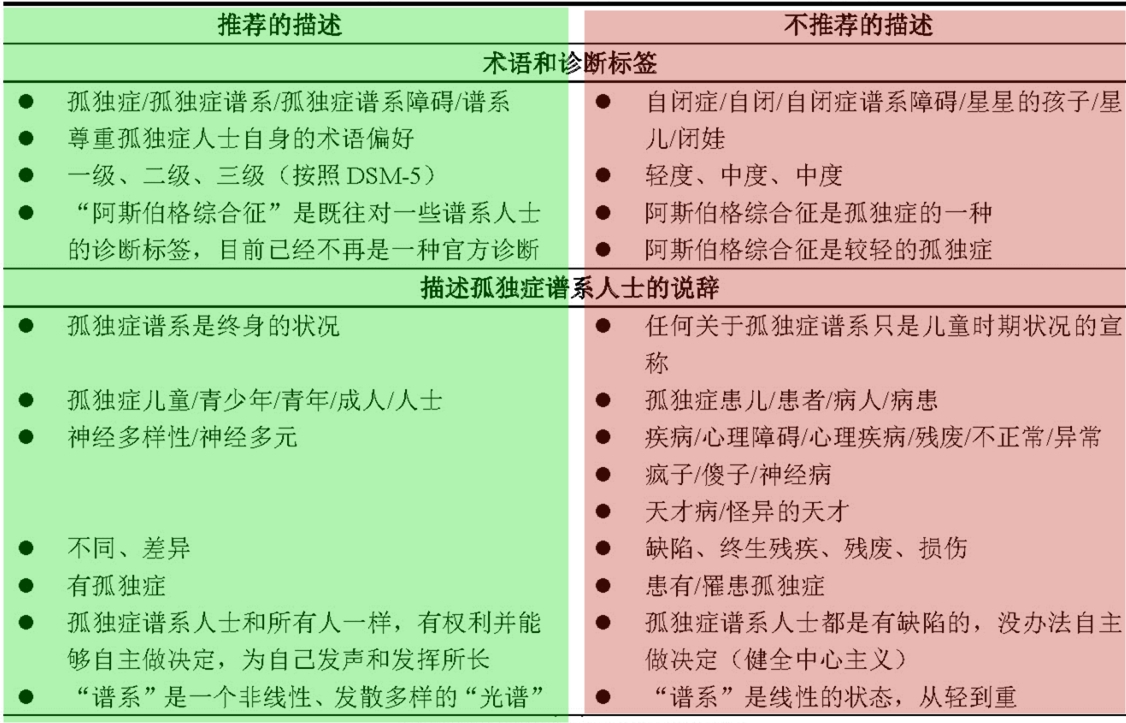
Deep Dive
What is neurodiversity and how does it differ from traditional views of neurological conditions?
Neurodiversity refers to the natural variation in human brain function and cognition, encompassing conditions like autism, ADHD, and dyslexia. Unlike traditional views that label these as disorders or deficits, neurodiversity frames them as natural variations that contribute to human creativity and diversity. This concept, introduced by Judy Singer in 1997, emphasizes that neurological differences should be respected and supported rather than pathologized.
Why is the term 'autism' preferred over 'autism spectrum disorder' in some communities?
Many in the autism community prefer 'autism' or 'autism spectrum' over 'autism spectrum disorder' because the latter term carries a medicalized and deficit-focused connotation. The term 'autism' is seen as more neutral and less stigmatizing, whereas 'disorder' implies a need for fixing or curing, which can be offensive to those who view autism as a natural part of human diversity.
What are some common misconceptions about neurodiverse individuals?
Common misconceptions include viewing neurodiverse individuals as solely defined by their challenges or deficits. For example, terms like 'high-functioning' or 'low-functioning' oversimplify their abilities and ignore the complexity of their experiences. Additionally, societal stereotypes often portray neurodiverse individuals as lacking empathy or social skills, when in reality, many are highly empathetic but may express it differently.
How does the neurodiversity movement view the role of societal environments in supporting neurodiverse individuals?
The neurodiversity movement emphasizes that societal environments play a crucial role in supporting neurodiverse individuals. Instead of focusing solely on individual deficits, it advocates for creating inclusive environments that accommodate diverse neurological needs. For example, providing sensory-friendly spaces or flexible work arrangements can help neurodiverse individuals thrive without requiring them to conform to neurotypical standards.
What challenges do neurodiverse individuals face in educational and work settings?
Neurodiverse individuals often face challenges such as rigid educational structures, lack of understanding from peers and educators, and workplace environments that do not accommodate their needs. For example, ADHD individuals may struggle with traditional deadlines, while autistic individuals may find open-plan offices overwhelming. These challenges highlight the need for systemic changes to foster inclusivity and support.
Why is self-identification important for neurodiverse individuals?
Self-identification allows neurodiverse individuals to take ownership of their experiences and seek support on their own terms. It empowers them to define their identity rather than being labeled by others, which can lead to stigma or misunderstanding. For many, recognizing their neurodiversity is a crucial step toward self-acceptance and finding strategies to navigate their unique challenges.
How can neurotypical individuals better support their neurodiverse peers?
Neurotypical individuals can support their neurodiverse peers by fostering understanding, practicing patience, and creating inclusive environments. This includes avoiding assumptions about abilities, providing clear communication, and being open to different ways of thinking and working. Small adjustments, like offering flexible deadlines or quiet spaces, can make a significant difference in supporting neurodiverse individuals.
What role does media play in shaping perceptions of neurodiversity?
Media plays a significant role in shaping perceptions of neurodiversity, often perpetuating stereotypes or oversimplifying complex experiences. For example, portrayals of autism as a tragedy or ADHD as a lack of discipline can reinforce stigma. Responsible media representation should focus on diverse, authentic stories that highlight the strengths and challenges of neurodiverse individuals without resorting to harmful clichés.
- 神经多样性指人类神经系统存在自然变异现象,大脑连接方式和功能存在差异,不应被完全视为疾病
- 涵盖孤独症谱系障碍、ADHD、阅读障碍等多种状况
- 概念由Judy Singer于1997年提出,强调大脑差异的自然性和重要性
Shownotes Transcript
什么是“神经多样性”呢?其实,就像地球上的生物有“生物多样性”,人的大脑也有多种多样的差异,每个人如何去思考,体验到怎样的情绪,如何去看待和感觉这个世界,都是不同的。
在所有人群里,大约10~20%的人属于神经多样性。孤独症谱系障碍、阅读障碍、运动和协调障碍、注意缺陷与多动障碍……都是神经多样性家庭成员。
对神经多样性人士来说,社会上依然存在着许多误解、刻板印象、居高临下和大惊小怪。对神经多样性人士的称呼和描述,有很多他们其实并不喜欢,甚至会感觉被冒犯。

这一期,我们请来了在中山大学附属第三医院研究谱系社区的朱绘霖博士,以及本身是神经多样性人士的科学传播者梁嘉歆(keledoll),一起展开聊聊:
●到底什么是神经多样性?
● 谱系孩子在成长过程里,可能会遇到多少坑?
● 为什么现在认为谱系比起“疾病”更接近“障碍/残障”?这二者的区别在哪里?
● 为什么大众和媒体应该避免使用如下用词:“闭娃”、“星儿”、“高/低功能”、“自闭症”和“自闭症谱系障碍”?
● 如果你怀疑自己可能是一个神经多样性人士,应该如何去确认,如何与自己和解?
……
一些谱系人士的自倡导文章,推荐阅读:
📄 天宝·格兰丁(Temple Grandin)所写的系列书籍。
🌰本期人物🌰
嘉宾, 朱绘霖,心理学博士,中山大学附属第三医院儿童发育行为中心研究人员,心理治疗师。
嘉宾,梁嘉歆(keledoll),友心人心理社区发起人,神经多样性倡导活动策划人。
主播,游识猷,果壳主笔。
🌰时间轴🌰
04:47 什么是神经多样性(neural diversity)?
06:55 大脑不一样的人,想问题的方式就是会和其他人不一样。
08:06 看的资料越来越多,发现自己从小到大哪个脑子也不太一样。
08:35 人生99%的时间都不知道自己在干什么,只有1%的时间是“超级注意力”状态。
09:50 孤独症谱系、ADHD、社交障碍、语言障碍、运动障碍、发育协调障碍、读写障碍、学习障碍……其实都属于神经多样性。
11:56 女儿在幼儿园的三年里,几乎都不说话。
12:45 个体与环境的相互作用很重要,有些环境里,障碍可能会消失,变得没有问题。不能把所有挑战都归为个体的问题,而是要考虑个体与环境的匹配和协调。
14:13 每时每刻都在说话,说出声是在帮助我思考。
18:58 有些孤独症小伙伴对于社交信号不那么敏感,但还是可以感受到的,只是需要更多的时间、提示或者支持。
19:28 也有些谱系小伙伴是过于敏锐,共情了整个环境的氛围,然后被淹没以至于想逃避。
21:41 有些称呼和术语,孤独症谱系社群比较能接受,有些他们则不太喜欢。
24:10 不要使用“高功能/低功能”这样的描述。
30:28 “星星的孩子”这个描述,会不会被反向贴了标签?
33:12 不要单纯定义为“疾病”,如果纯粹是医疗的视角,就会忽略了环境的建设。
38:28 一个谱系孩子成长过程里,会遇到多少坑?
40:34 对6岁之前的关注和支持比较多,但对于谱系青少年和成人的支持和服务就太少了。
42:50 30 年里,你每一天醒来的时候,你都会跟自己讲,今天能不能不要丢东西?今天能不能把计划的事情做完?然后你每天都做不到。
48:55 成年后才发现自己是神经多元人群的人,至少有一半在此之前已经有精神心理方面的其他诊断了。他们经历了无数来自社会的不理解,工作人际上的挫败,才发现自己的与众不同其实已经存在很久。
51:30 我的7岁孩子看20分钟的电视,在家里已经跑了100个圈。
54:40 我的运气很好,同学、家人、伴侣,都非常包容我的状态和思考。
57:34 当神经多样性人士来做自倡导,他们能讲出自己在某个情境下到底是什么样的感受。
59:22 神经典型人如何和谱系小伙伴顺畅地合作?
01:04:51 谱系社群对于语言里含有的隐形歧视、二元对立,是很介意的。
01:10:54 “赋能”并不是给别人一个能力,而是扫清这个社会上的障碍,去除对他们的偏见跟歧视,创造一个他们也有机会工作和就业的环境。
01:13:41 如果你怀疑自己属于神经多样性人群,或者你怀疑身边的某个亲人是属于神经多样性的人群,应该怎么做呢?
01:22:30 神经多样性依然是一个开放的讨论,希望不同的群体代表之间,能有更多的交流和对话。
本期嘉宾: 朱绘霖,梁嘉歆(keledoll)
主播:游识猷
后期: Yann
欢迎收听果壳时间,这是一档果壳推出的播客节目,主播们会和嘉宾一起,提供多学科视角,还原科技的复杂性,将热议话题深挖一层。
你可以在小宇宙、苹果播客、喜马拉雅、网易云音乐、QQ音乐、豆瓣、Spotify等平台找到我们。
欢迎留下评论,你的意见对我们很重要。